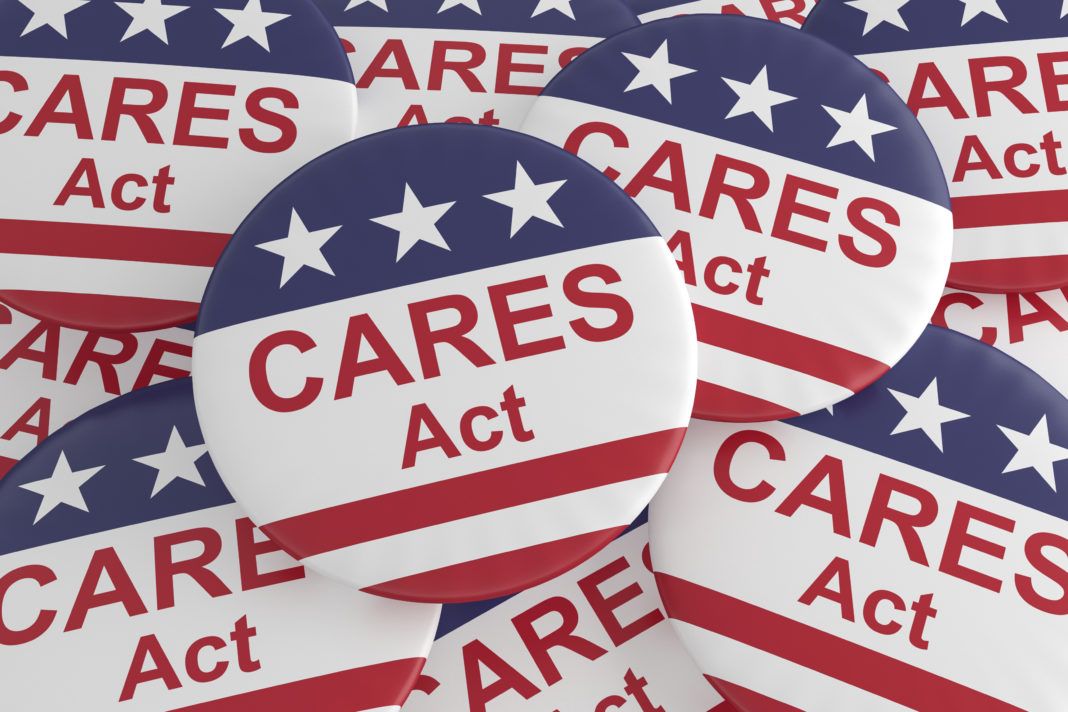Sponsored by
By The CSRS Disaster Recovery Team
On March 27, 2020, President Trump signed into law the CARES Act.
The nearly $2.2 trillion relief package is the boldest action to date in response to the COVID-19 pandemic and is the single largest relief bill in U.S. history.
The CARES Act (880-page bill) includes: direct financial assistance to Americans; aid to small businesses and employees; efforts to stabilize the economy and keep people employed; and additional support for health care professionals, patients, and hospitals.
The CARES Act, also known as “Phase III,” follows a $104 billion response package signed into law on March 18 (H.R. 6201, “Phase II”), which aimed to expand benefits for workers and provide nutritional assistance to families, and a smaller $8 billion package (H.R. 6074, “Phase I”) earlier this month to boost funding for medical treatments and testing.
Lawmakers are currently under discussion of a fourth stimulus package focusing on infrastructure.
The following is an overview of inclusions within the CARES Act and a breakdown of allocations that could impact public and non-profit entities. It is not an all-inclusive summary of each provision within the CARES Act. The information provided reflects the distribution of funds but doesn’t provide the specific details of eligible activities and required documentation from each Federal entity. We anticipate that this information will become available following the Easter holiday, April 12, 2020.
The CARES Act has two divisions (bolded sections are most applicable to public and non-profit entities):
Division A (Authorizing Language and Mandatory Spending)
• $250 billion set aside for direct payments to individuals and families (with most American adults receiving $1,200 and most children $500).
• $377 billion in small business loans.
• $260 billion in unemployment insurance benefits.
• $500 billion in loans for distressed companies. (more details below)
• $150 billion to assist states and localities.
• $150 billion for hospitals to invest in equipment and infrastructure.
Division B (Emergency Discretionary Appropriations)
• Includes $330 billion in federal funding to respond to the COVID-19 outbreak. This includes direct appropriations to support federal departments and agencies and appropriations to disperse through grants, loans, and other mechanisms to combat the outbreak and buttress the economy during this turbulent time.
Division A – Authorizing Language and Mandatory Spending
Loans to distressed companies – $500 billion: Loans, loan guarantees, and other investments for distressed economic sectors which will be administered by Treasury.
• $46 billion is targeted specifically at passenger air carriers, cargo air carriers, and businesses critical to national security.
• $454 billion is authorized for Federal Reserve Loans, loan guarantees and investments to assist other eligible businesses, states and municipalities, Treasury is given broad discretion to administer these programs. On or before April 6 (within 10 days of the law’s enactment), the Secretary of the Treasury must promulgate procedures for administering these funds.
State and Local Expenditures Fund – $150 billion (Section 5001(d)): Direct assistance for states, tribes, and local governments that must pay for new expenses related to COVID-19 response.
• $139 billion is allocated to state governments in the 50 states, with allocations based on their populations and with no state receiving less than $1.25 billion.
• $8 billion allotted for tribes.
• $3 billion is allocated to governments in territories, including DC and Puerto Rico.
• Allocations to governments within states or territories: Additional funding can be allocated for local governments. Direct assistance from the Dept. of Treasury will go to a local government servicing a population of at least 500,000, as measured in the most recent census data. However, if a state does not have a municipal government meeting that population threshold, the additional local government funding will be direct through the state. Direct local assistance allocations reduce the allocation that is made to the state government (keeping the state allocation constant) and are equal to the product of:
-
- the state or territory allocation amount,
- the share of the state or territory population serviced by the local government, and
- 45%.
• Specifically, it allows state and local government to make payments for programs that:
-
- are necessary expenditures incurred due to the public health emergency with respect to Coronavirus Disease 2019 (COVID-19);
- were not accounted for in the budget most recently approved as of the date of enactment [March 27, 2020] of this section for the State or government; and
- were incurred during the period that begins on March 1, 2020 and ends on December 30, 2020.
• It may not be used to directly account for revenue shortfalls related to the COVID-19 outbreak. Such funds, however, may indirectly assist with revenue shortfalls in cases where expenses paid for by the Coronavirus Relief Fund would otherwise widen the gap between government outlays and receipts.
Hospitals – Equipment and Infrastructure – $150 billion: Health Care Systems (Title III, Subtitles A and D)
• Clarifies that the Strategic National Stockpile can stockpile medical supplies, such as testing swabs.
• Provides permanent liability protection for manufacturers of respirators.
• Requires FDA to prioritize and expedite the review of drug applications and inspections to prevent a drug shortage.
• Requires drug manufacturers to submit more information when there is an interruption in supply and to maintain contingency plans to ensure a backup supply of products.
• During a public health emergency, clarifies that medical device manufacturers are required to submit information about a device shortage upon request of FDA.
• Clarifies all testing for COVID-19 is to be covered by private insurance plans (without cost-sharing).
• Provides free coverage of a COVID-19 vaccine (without cost-sharing) within 15 days.
• Provides $1.32 billion in supplemental funding to community health centers for testing and treating of COVID-19.
• Reauthorizes grant programs that promote the use of telehealth technologies, including the expansion of telehealth access, insurance coverage, rural telehealth access, Medicare reimbursement for services, and others.
• Reauthorizes rural health care services programs.
• Allows nurse practitioners and physicians’ assistants to prescribe home health services.
• Supports the healthcare workforce, including reauthorization of health professions workforce programs, education and training related to geriatrics, and nursing workforce development.
• Removes barriers to allow the Biomedical Advanced Research and Development Authority (BARDA) to partner with private sector on research and development and to allow BARDA to expedite diagnostics and vaccines.
Medicare and Medicare Provisions: (Title III)
• Allows for accelerated Medicare payments.
• Creates a 20 percent add-on payment for inpatient treatment.
• Increases payments for the work component of physician fees in areas where labor cost is determined to be lower than the national average through December 1, 2020.
• Extends funding for quality measure endorsement input, and selection increased to $20 million for each of the years 2020 and 2021.
• Extends funding for beneficiary outreach and counseling related to low-income programs through November 30, 2020.
• Increases Medicare Access to Post-Acute Care.
• Delays scheduled reductions in Medicaid disproportionate share hospital payments through November 30, 2020.
• Extends the Medicaid Community Mental Health Services demonstration that provides coordinated care to patients with mental health and substance use disorders, through November 30, 2020.
Download ‘The Cares Act: A Breakdown & Highlights
for Public & Nonprofit Entities’ from CSRS here.
Division B – Emergency Discretionary Appropriations for Health Response and Agency Operations – $330 billion
Health and Human Services – $100 billion: To be distributed to “eligible health care providers” through grants or “other mechanisms” for health care related expenses or lost revenues that are attributable to coronavirus domestically or internationally. These funds may not be used to reimburse expenses or loses that may or have been reimbursed from other sources.
• Eligible health care providers are “public entities, Medicare or Medicaid enrolled suppliers and providers, and such for-profit entities and not-for-profit entities not otherwise described as specified by HHS, located within the United States (including territories) that provide diagnoses, testing, or care for individuals with possible or actual cases of COVID–19.”
• In order to receive a payment under this appropriation, an eligible health care provider must submit an application to HHS that includes a statement justifying the provider’s need for the funding as well as a valid tax identification number. HHS will, review provider applications and make payments provided for under the Act.
• The CARES Act notes that funds appropriated under this provision may be used for the building or construction of temporary structures, the leasing of properties, medical supplies and equipment including personal protective equipment and testing supplies, increased workforce and trainings, emergency operation centers, retrofitting facilities, and surge capacity for hospitals and other health care facilities. This funding is subject to established HHS funding conditions and documentation requirements
-
- $27 billion to prevent, prepare for, and respond to coronavirus, including the development of necessary countermeasures and vaccines, prioritizing the purchase of vaccines, medical surge capacity, telehealth access and infrastructure, and other preparedness and response activities. Of the $27 billion, no less than $250 million will be made available for grants or cooperative agreements with entities that are either grantees or sub-grantees of the Hospital Preparedness Program under the Public Health Service Act (PHSA), or that meet other criteria prescribed by the HHS Secretary.
Department of Transportation: Earmarked for transportation activities to address the COVID-19 outbreak. This funding addresses the specialized transportation workforce to mitigate furloughing of 1.6 million employees, provide safe conditions for workers, and maintain mobility assets for commuters and the traveling public.


Amtrak and Rail Safety — $1.018 billion: Available to Amtrak to adjust to changing operational needs due to significant reductions in passenger rail service in the Northeast corridor as well as other state-supported and long-distance routes. This provision includes direct funding to states to assist in meeting obligations under the FAST Act. Additionally, the bill provides $250,000 to the Federal Railroad Administration for safety equipment and other assistance to inspectors in responding to COVID-19.
Transit Systems — $25 billion: Funding is provided to public transit operators to protect public health and safety while ensuring transportation access to jobs, medical treatment, food, and other essential services remain available during the COVID-19 response. As the revenues that sustain this essential service are severely impacted due to a reduction in fare box revenue and dedicated sales taxes, this federal investment will help to sustain more transit jobs and preserve access to public service and critical workforce that are the backbone of our COVID-19 prevention, response, and recovery efforts.
Essential Air Service — $56 million: Funding for the Essential Air Service and Rural Improvement Fund, to remain available until expended, to prevent, prepare for, and respond to coronavirus while maintaining commercial air service to small and rural communities.


Economic Development Administration (EDA) — $1.5 billion (Title II): Funding to help revitalize local communities after the pandemic. This money may be used to rebuild impacted industries such as tourism or manufacturing, as well as capitalize local funds to provide low-interest loans to any business.
Manufacturing Support – $50 million: Provided for the Hollings Manufacturing Extension Partnership to help small and medium-sized manufacturers recover by finding value within the supply chain and expanding markets. The bill also includes an additional $10 million for the National Institute for Innovation in Manufacturing Biopharmaceuticals to support the development and manufacture of new medical countermeasures and biomedical supplies to combat the coronavirus.
Assistance for Fishermen —$300 million: Funding to help fishermen nationwide who are suffering due to disappearing economic markets. Eligible parties include tribal, subsistence, commercial, and charter fishermen, as well as aquaculture farmers. The eligibility criteria for such funds is as follows:
• Economic revenue losses greater than 35 percent compared to the prior five-year average revenue; or
• Any negative impacts to subsistence, cultural, or ceremonial fisheries.
• Funds remain available until September 30, 2021
Army Corps of Engineers (USACE) – $70 million: Funding to prepare for and respond to the coronavirus by providing additional equipment, licenses, and IT support to improve teleworking capabilities and ensure secure remote access for corps staff. Funding will also improve capacity for remote operations of USACE projects and activation of Emergency Operations Centers nationwide to support continued operations of USACE projects.
National Endowment for the Art and Humanities —$150 million: Funding for state arts and humanities agencies to provide grants and support arts organizations, museums, libraries, and other organizations during the coronavirus crisis.
• The bill includes $75 million for the National Endowment for the Arts and $75 million for the National Endowment of the Humanities.
Institute for Museum and Library Services — $50 million: Funding for the Institute of Museum and Library Services to expand digital network access in areas of the country where such access is lacking, including the purchase of internet-enable devices and provisions for technical support services in response to the disruption of schooling and other community services during the COVID-19 emergency.
Federal Emergency Management Agency (FEMA) — $45.4 billion
- Continuation of FEMA’s response and recovery activities and to reimburse states and localities (via Project Worksheets) through the Disaster Relief Fund for emergency and major disaster declarations.
- $400 million of this allocation is for grants for firefighters, emergency managers, and providers of emergency food and shelter.
- $100 million of the FEMA funds is for Assistance to Firefighter Grants for the purchase of personal protective equipment and related supplies
- $200 million for the Emergency Food and Shelter Program
- The Emergency Food and Shelter program uses funds, as determined by the local board in funded jurisdictions, to provide served meals, groceries, lodging in mass shelter or hotels, rent and mortgage assistance, and equipment necessary to feed or shelter people. Funding is available to governmental and nonprofit organizations
Community Development Block Grant (CDBG) — $5 billion: CDBG is a flexible program that provides communities and states with funding to provide a wide range of resources to address COVID-19, such as services for senior citizens, the homeless, and public health services.
- $2 billion of the provided funds is to be distributed pursuant to formula, within 30 days of enactment, to grantees that received allocations in fiscal year 2020.
- $1 billion is to be allocated directly to states to prevent, prepare for, and respond to coronavirus, including activities within entitlement and non-entitlement communities. The remaining amounts are to be distributed directly to states or local governments at the discretion of the Secretary of Housing and Urban Development.
Tenant-Based Rental Assistance — $1.25 billion: Provided to preserve Section 8 voucher rental assistance for seniors, the disabled, and low-income working families, who will experience loss of income from the coronavirus.
• $850 million is available for public housing agency expenses, including Mainstream vouchers that assist non-elderly persons with disabilities. This funding will also help cover costs related to the retention and support of participating owners.
• $400 million is available for adjustments in calendar year 2020 to Section 8 renewal funding allocations, in addition to any other available appropriations, for public housing agencies that experience an increase in voucher per-unit costs due to extraordinary circumstances, or that, , would otherwise be required to terminate rental assistance for families due to insufficient funding.
• The Secretary of HUD may also award any remaining unobligated balances under this section from prior appropriations acts for tenant-based assistance contracts, to prevent, prepare for, and respond to coronavirus.
Housing Opportunities for Person with AIDS (HOPWA) — $65 million: Provided under the legislation for HOPWA, the program dedicated to the housing needs of people living with HIV/AIDS by giving grants to local communities, states, and nonprofit organizations for projects that benefit low-income persons living with HIV/AIDS and their families.
• $50 million is to be allocated pursuant to formula,
• $10 million is to be provided for additional one-time, non-renewable awards to grantees currently administering existing contracts for permanent supportive housing.
• Funding under this section may be used to self-isolate, quarantine, or to provide other coronavirus infection control services recommended by the CDC, including for relocation services and lodging at hotels.
RECONNECT Pilot Grants — $100 million: Funding provided in the legislation for additional grants under the RECONNECT pilot program established by the Consolidated Appropriations Act, 2018 (Public Law 115-141).
• These funds are being made available to conduct new broadband loan and grant projects under the authority of the Rural Electrification Act of 1936.


- these funds are being made available to encourage and improve telemedicine services and distance learning services in rural areas through the use of telecommunications, computer networks, and related advanced technologies by students, teachers, medical professionals, and rural residents.
- The Treasury Secretary is authorized to provide financial assistance for the purpose of financing the construction of facilities and systems to provide telemedicine services and distance learning services in rural areas.
OTHER PROVISIONS:
• $30.75 billion for the Education Stabilization Fund, which are grants to provide emergency support to local school systems and higher education institutions to support ongoing functionality during the crisis. (Title III, Subtitle B)
-
- It also authorizes the Department of Education to defer payments on current HBCU Capital Financing loans during the national emergency period.
• $16 billion to replenish the Strategic National Stockpile supplies of pharmaceuticals, personal protective equipment, and other medical supplies, which are distributed to state and local health agencies, hospitals and other healthcare entities facing shortages during emergencies.
• $11 billion to support research and development of vaccines, therapeutics, and diagnostics to prevent or treat the effects of coronavirus.
• $1 billion for the Defense Production Act to support domestic supply chains, enabling industry to quickly increase production of personal protective equipment, ventilators, and other medical supplies.
• $4.3 billion to the Centers for Disease Control for federal, state, and local public health agencies to respond to COVID-19, including for the purchase of personal protective equipment, laboratory testing to detect positive cases, infection control and mitigation at the local level to prevent the spread of the virus; and other public health preparedness and response activities.
• $185 million through the Health Resources and Services Administration to support rural critical access hospitals, rural tribal health and telehealth programs.
• $200 million for the Centers for Medicare and Medicaid Services (CMS) for priorities such as assisting nursing homes with infection control and support states’ efforts to prevent the spread of coronavirus in nursing homes.
• $3.5 billion in additional funding for Child Care Development Block Grants to provide childcare assistance to healthcare sector employees, emergency responders, sanitation workers, and other essential workers.
• $25 billion for food assistance, including nearly $16 billion for the Supplemental Nutrition Assistance Program (SNAP) and nearly $9 billion for child nutrition.
• $7 billion for affordable housing and homelessness assistance programs.
• $400 million in election assistance for states, including to increase the ability to vote by mail, expand early voting and online registration, and increase the safety of voting in-person through additional voting facilities and more poll-workers.
• $2 million for the Department of Justice for “information sharing technology.”
• $2 billion to strengthen response capacity for tribal governments.
Sources
- https://www.congress.gov/bill/116th-congress/senate-bill/3548/text
- https://www.natlawreview.com/article/summary-cares-act
- https://crsreports.congress.gov/product/pdf/R/R46298
- https://www.cozen.com/news-resources/publications/2020/summary-and-analysis-of-key-provisions-of-the-cares-act#emergencyappropriations
- https://www.npr.org/2020/03/26/821457551/whats-inside-the-senate-s-2-trillion-coronavirus-aid-package
 GET DAILY REPORT FREE
GET DAILY REPORT FREE







